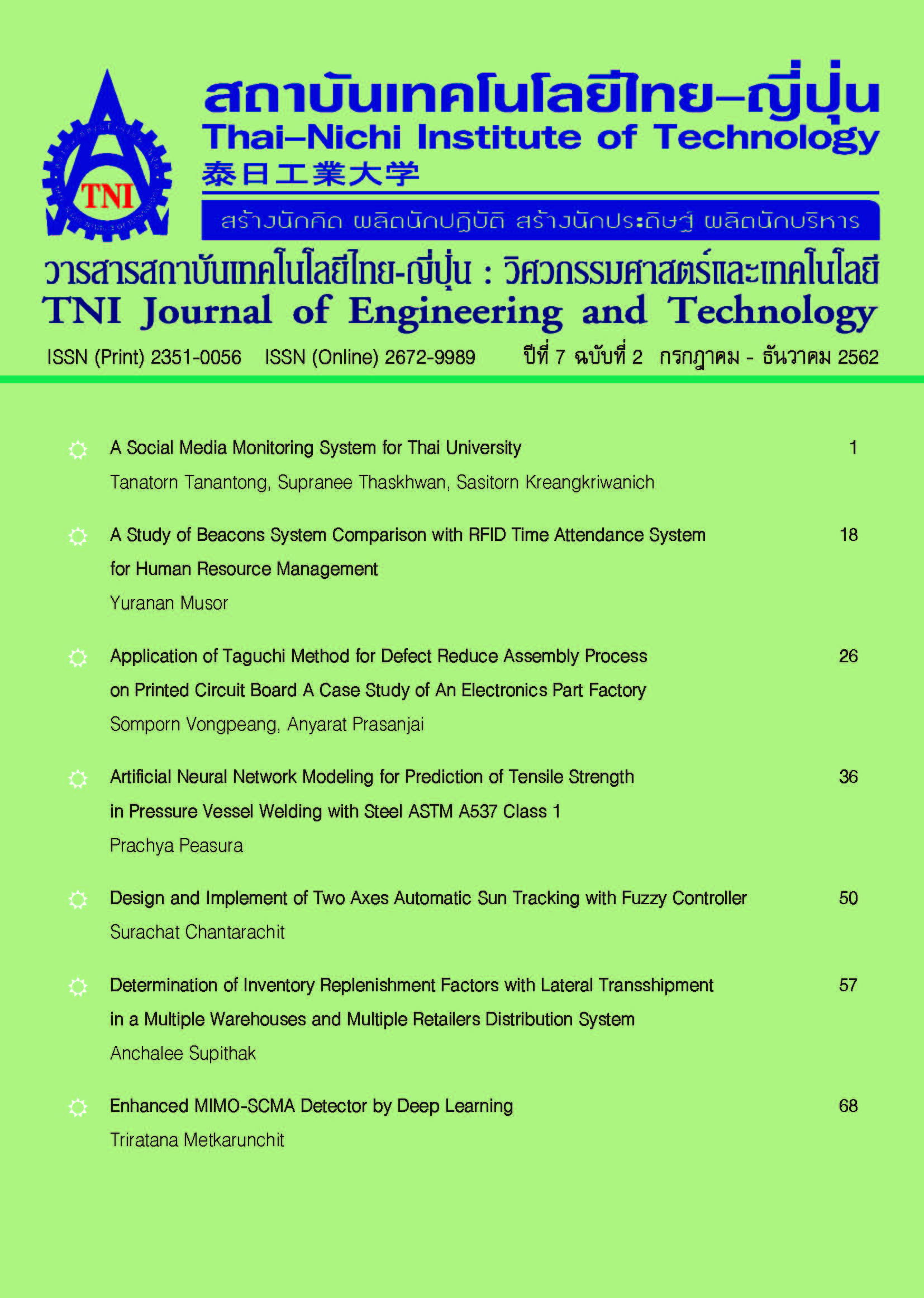การประยุกต์วิธีการทากูชิ เพื่อลดชิ้นงานเสียในกระบวนการประกอบแผ่นวงจรพิมพ์พีซีบี กรณีศึกษาโรงงานผลิตชิ้นส่วนอิเล็กทรอนิกส์
Main Article Content
บทคัดย่อ
งานวิจัยนี้มีวัตถุประสงค์เพื่อลดของเสียในกระบวนการประกอบแผ่นวงจรพิมพ์พีซีบี จากการศึกษากระบวนการผลิต ณ โรงงานกรณีศึกษา มีปริมาณของเสียร้อยละ 4.39 ก่อนการปรับปรุง ซึ่งขั้นตอนการดำเนินงานประกอบด้วยการนำแผนภูมิพาเรโตมาใช้จัดลำดับปัญหาที่เกิดขึ้นร่วมกับการใช้แผนผังแสดงเหตุและผลในการหาปัจจัยที่ส่งผลกระทบกับปัญหา จากนั้นออกแบบการทดลองด้วยวิธีทากูชิ เพื่อหาค่าระดับของปัจจัยที่เหมาะสม สำหรับปัจจัยที่มีอิทธิพลของกระบวนการ ซึ่งได้แก่ ความเร็ว (Squeegee Speed), แรง (Squeegee Force), และ ความสูง (Board Size Height) การออกแบบการทดลองถูกใช้เป็นเครื่องมือในการกำหนด ค่าพารามิเตอร์ โดยการพิจารณาค่า signal to noise ratio ที่ทำให้เกิดค่า smaller the better
จากการทดลองพบว่า ค่าพารามิเตอร์ที่เหมาะสมที่สุดดังนี้ คือ ความเร็ว (Squeegee Speed) คือ 30 มิลลิเมตรต่อวินาที แรง (Squeegee Force) คือ 20 นิวตัน และความสูง (Board Size Height) คือ 1.0 มิลลิเมตร เมื่อมาปรับตั้งค่าพารามิเตอร์ของเครื่องพิมพ์ตะกั่ว ทำให้ของเสียต่อเดือนลดลงเหลือร้อยละ 2.58 ซึ่งจากเดิมของเสียต่อเดือนร้อยละ 4.39 ของเสียลดลงร้อยละ 40เป็นไปตามเป้าหมายที่ตั้งไว้
Article Details
นโยบายการรับบทความ
กองบรรณาธิการวารสารสถาบันเทคโนโลยีไทย-ญี่ปุ่น มีความยินดีรับบทความจากอาจารย์ประจำ และผู้ทรงคุณวุฒิในสาขาวิศวกรรมศาสตร์และเทคโนโลยี ที่เขียนเป็นภาษาไทยหรือภาษาอังกฤษ ซึ่งผลงานวิชาการที่ส่งมาขอตีพิมพ์ต้องไม่เคยเผยแพร่ในสิ่งพิมพ์อื่นใดมาก่อน และต้องไม่อยู่ในระหว่างการพิจารณาของวารสารอื่นที่นำส่ง ดังนั้นผู้สนใจที่จะร่วมเผยแพร่ผลงานและความรู้ที่ศึกษามาสามารถนำส่งบทความได้ที่กองบรรณาธิการเพื่อเสนอต่อคณะกรรมการกลั่นกรองบทความพิจารณาจัดพิมพ์ในวารสารต่อไป ทั้งนี้บทความที่สามารถเผยแพร่ได้ประกอบด้วยบทความวิจัย ผู้สนใจสามารถศึกษาและจัดเตรียมบทความจากคำแนะนำสำหรับผู้เขียนบทความ
การละเมิดลิขสิทธิ์ถือเป็นความรับผิดชอบของผู้ส่งบทความโดยตรง บทความที่ได้รับการตีพิมพ์ต้องผ่านการพิจารณากลั่นกรองคุณภาพจากผู้ทรงคุณวุฒิและได้รับความเห็นชอบจากกองบรรณาธิการ
ข้อความที่ปรากฏภายในบทความของแต่ละบทความที่ตีพิมพ์ในวารสารวิชาการเล่มนี้ เป็น ความคิดเห็นส่วนตัวของผู้เขียนแต่ละท่าน ไม่เกี่ยวข้องกับสถาบันเทคโนโลยีไทย-ญี่ปุ่น และคณาจารย์ท่านอื่น ๆ ในสถาบัน แต่อย่างใด ความรับผิดชอบด้านเนื้อหาและการตรวจร่างบทความแต่ละบทความเป็นของผู้เขียนแต่ละท่าน หากมีความผิดพลาดใด ๆ ผู้เขียนแต่ละท่านจะต้องรับผิดชอบบทความของตนเองแต่ผู้เดียว
กองบรรณาธิการขอสงวนสิทธิ์มิให้นำเนื้อหา ทัศนะ หรือข้อคิดเห็นใด ๆ ของบทความในวารสารสถาบันเทคโนโลยีไทย-ญี่ปุ่น ไปเผยแพร่ก่อนได้รับอนุญาตจากผู้นิพนธ์ อย่างเป็นลายลักษณ์อักษร ผลงานที่ได้รับการตีพิมพ์ถือเป็นลิขสิทธิ์ของวารสารสถาบันเทคโนโลยีไทย-ญี่ปุ่น
ผู้ประสงค์จะส่งบทความเพื่อตีพิมพ์ในวารสารวิชาการ สถาบันเทคโนโลยีไทย-ญี่ปุ่น สามารถส่ง Online ที่ https://www.tci-thaijo.org/index.php/TNIJournal/ โปรดสมัครสมาชิก (Register) โดยกรอกรายละเอียดให้ครบถ้วนหากต้องการสอบถามข้อมูลเพิ่มเติมที่
- กองบรรณาธิการ วารสารสถาบันเทคโนโลยีไทย-ญี่ปุ่น
- ฝ่ายวิจัยและนวัตกรรม สถาบันเทคโนโลยีไทย-ญี่ปุ่น
เลขที่ 1771/1 สถาบันเทคโนโลยีไทย-ญี่ปุ่น ซอยพัฒนาการ 37-39 ถนนพัฒนาการ แขวงสวนหลวง เขตสวนหลวง กรุงเทพมหานคร 10250 ติดต่อกับคุณพิมพ์รต พิพัฒนกุล (02) 763-2752 , คุณจุฑามาศ ประสพสันติ์ (02) 763-2600 Ext. 2402 Fax. (02) 763-2754 หรือ E-mail: JEDT@tni.ac.th
เอกสารอ้างอิง
[2] D.C. Montgomery, Design and Analysis of Experiments, 6th ed.USA.: John Wiley & Sons, 2005.
[3] G. Taguchi, Taguchi Techniques for Quality Engineering, New York: McGraw-Hill, 1988.
[4] Roy, R.K., A primer on the Taguchi competitive manufacturingSeries, New York: Van Nostrand Reinhold, 1990.
[5]Chalida Chanwichit, “Application of Taguchi method to reduce packet loss,”(In Thai), IE Network 2015 SILPAKORN UNIVERSITY, pp. 36-40, April 6-7, 2015.
[6] Srinivas Athrey,“Application Of Taguchi Method For Opti-mization Of Process Parameters In Improving The Surface Roughness Of Lathe Facing Operation,”International Refereed Journal of Engineering and Science (IRJES), Vol. 1, No. 3, pp.13-19, November 2012.
[7] Wanruedee Intananok, “DETERMINE PROPER CONDITIONS TO REDUCE DEFECTIVES IN A SOLDER PASTE SCREEN PRINTING PROCESS”, Master of Engineering thesis, Industrial Engineering Department, Chulalongkorn University, Bangkok, Thailand, 2015.
[8] Surapong Bangphan, “Application of Taguchi Method for Optimizing Turning Process by Studying of Production Machining Parameter,”(In Thai), UBU Engineering Journal, Vol.7, No.2, pp. 104-112, July-December 2014.


